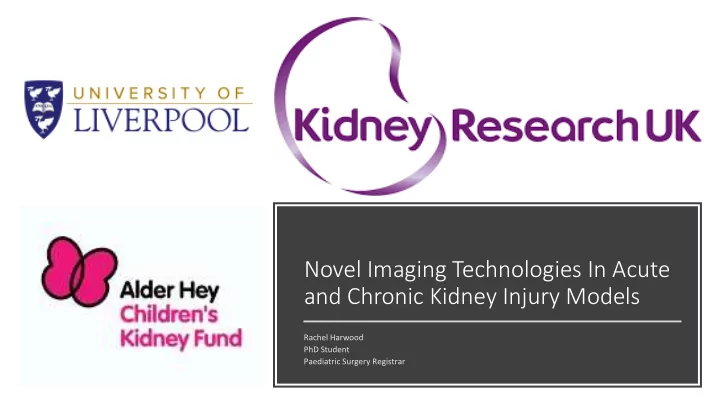

Novel Imaging Technologies In Acute and Chronic Kidney Injury Models Rachel Harwood PhD Student Paediatric Surgery Registrar
15% of inpatients 40% children on PICU Long term morbidity £1.44-£1.45 Billion, per year
Models of injury • Nephrotoxicity models • Surgical models • Cisplatin • Ischaemia Reperfusion Injury • Adriamycin • 5/6 nephrectomy • Folic Acid • Ureteric Obstruction • Warfarin • Gentamycin • Systemic models • Sepsis • Diabetic nephropathy • Rhabdomyolysis (Glycerol)
Ischaemia Reperfusion Injury
Monitoring Disease Progression NAG Transcutaneous FITC- Urine α-GST Creatinine Sinistrin Clearance Serum β 2- MG BUN ɑ 1 -MG Ultrasound Imaging Cys-C RBP DMSA TIS Cys-C Histology MAG3 Multi-spectral H&E MicroAlb ? MRI PicroRed KIM-1 optoacoustic Masson’s NGAL tomography (MSOT) IL-18 FABP Clearance of IRDye800 CW
FIT FITC-Si Sinistrin Cle Clear arance ance
Bilateral Ischaemia Reperfusion Injury GFR of all surviving animals RIFLE classification of GFR reduction 2500 200 25 minutes 25 minutes *** *** * Percentage GFR loss *** *** ** 27.5 minutes GFR ( µ l/min/100g) 27.5 minutes 2000 150 30 minutes 30 minutes 1500 Sham Sham 100 1000 Risk Injury 500 Failure 0 0 Day 0 Day 1 Day 3 Day 7 Day 14 Day 0 Day 1 Day 3 Day 7 Day 14 Correlation between anaesthetic duration, Correlation between clamping time, post clamping pre-clamping anaestheic time and day 1 GFR anaesthetic time and day 1 GFR Clamping time 150 Failure Total anaesthetic time r 2 - 0.13 Failure 50 r 2 - 0.50 p 0.1522 Duration (Minutes) p 0.0034 Duration (Minutes) 40 100 Post-clamping Pre-clamping 30 anaesthetic time anaesthetic time r 2 0.00 r 2 - 0.34 20 p 0.8559 50 p 0.0219 10 25 minute clamp 25 minute clamp 0 0 27.5 minute clamp 27.5 minute clamp 0 200 400 600 800 0 200 400 600 800 30 minute clamp 30 minute clamp Day 1 GFR ( µ l/min/100g) Day 1 GFR ( µ l/min/100g)
Day 14 after Bilateral IRI Serum Urea Serum Cystatin C Serum Creatinine 0.045 1.5 100 1.5 Creatinine (mg/dL) 80 Cystatin C (mg/l) Urea (mg/dL) 1.0 1.0 60 40 0.5 0.5 20 0.0 0 0.0 s s s m s s s m s s s m e e e e e e e e e a a a t t t t t t t t t h u u u h u u u h u u u n n n S n n n S n n n S i i i i i i i i i m m m m m m m m m 5 5 0 5 5 0 5 5 0 2 . 3 2 . 3 2 . 3 7 7 7 2 2 2 Relationship between acute injury and development Cortical collagen deposition 0.04 of cortical collagen deposition 6 Combined collagen deposition 8 25 minutes r 2 - 0.69 PSR Score 4 6 27.5 minutes p < 0.0001 30 minutes 4 Sham 2 2 0 0 Right Kidney Left Kidney Both Kidneys 0 500 1000 1500 2000 GFR ( µ l/min/100g)
MS MSOT
Unilateral Ischaemia Reperfusion Injury
IRI Chronic Kidney Disease Model
Refined Unilateral Ischaemia Reperfusion Injury Change in GFR over time Change in t max after unilateral IRI 2000 500 ** * Injured Kidney 400 GFR ( µ l/min/100g) Uninjured Kidney 1500 300 t max 1000 200 * p < 0.05 ** p < 0.01 100 500 0 0 -100 0 10 20 30 40 50 0 1 3 9 13 Day after R-IRI Day after R-IRI
PSR score Comparison of PSR score and GFR in CKD models Refined Unilateral 4 2000 r 2 - 0.93 Ischaemia GFR ( µ l/min/100g) p 0.0004 3 1500 PSR Score Reperfusion Injury 2 1000 500 1 0 0 0 1 2 3 4 5 1 2 3 4 5 PSR score Subject Creatinine Urea Cystatin C 1.5 250 3 Creatinine (mg/dL) 200 Cystatin C (mg/l) Urea (mg/dL) 1.0 2 150 100 0.5 1 50 0.0 0 0 1 2 3 4 5 1 2 3 4 5 1 2 3 4 5 Subject Subject Subject
Take Home Messages • The use of non-invasive monitoring can • enable better refinement of a kidney injury model • reduce the numbers of subjects required for efficacy studies • Has the potential to improve knowledge about mechanisms of injury • The future • Efficacy studies • Alternative dyes for MSOT • ? Translation to humans
Thanks to Prof P Murray Dr J Sharkey Prof S Kenny Dr L Scarfe Dr B Wilm Dr A Taylor
Recommend
More recommend